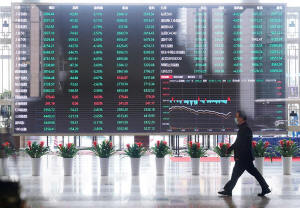US asset managers ready for turn in China sentiment with products
stacked up
 Send a link to a friend
Send a link to a friend
 [February 20, 2024] By
Suzanne McGee and Megan Davies [February 20, 2024] By
Suzanne McGee and Megan Davies
(Reuters) - Three straight years of losses from Chinese markets and
anti-Beijing rhetoric from Washington have not deterred some U.S. asset
managers from introducing products they hope will thrive if Chinese
stocks rebound.
China's markets have been hit by a long-lasting property crisis, slowing
growth and geopolitical tension. The Institute of International Finance
estimates $80 billion of outflows from Chinese portfolios last year, and
the bellwether blue-chip CSI 300 Index has fallen 43% from its record
high of three years ago. China's markets, which reopen on Feb. 19 after
the Lunar New Year holidays, are down nearly 2% year-to-date, bouncing
off lows on support measures from Beijing.
Despite the extended pain, U.S. fund managers with China-focused
products have been betting that investors will want to return to the
market, arguing that valuations make the country hard to ignore.
China's CSI 300 index currently trades at 12 times trailing 12-month
earnings, while the S&P 500 index's valuation is at 24 times 12-month
earnings, according to Morningstar Direct.
"This is potentially a once-in-a-lifetime opportunity to buy China
equities at valuation levels not seen for a long time," Jonathan Krane,
CEO of China-focused ETF provider KraneShares, said in an email.
KraneShares has launched four new China-focused exchange-traded funds
since the beginning of 2021. Its roster also includes one of the largest
China-focused ETFs, the KraneShares CSI China Internet ETF. Launched in
2013, it has about $5 billion in assets.

China's sheer size and economic growth rate - even if lower than in past
years - means investors need to have it in their allocations, fund
managers argue.
"Do we fundamentally think that the second-largest economy in the world
plays a role in investor portfolios? Yup, no question," said Bryon Lake,
global head of ETF Solutions at JP Morgan Asset Management. The firm
launched the JPMorgan Active China ETF in March 2023, which now has
about $9.2 million in assets.
In total there were four U.S.-based, China-focused ETFs launched in
2023, compared with two the prior year and eight in 2021, according to
Morningstar data, making a total of 48 US-based, China-focused ETFs at
the end of 2023. That takes into account both openings and closures and
is a figure little changed in the last several years but up 46% in the
last decade.
CHALLENGES IN CHINESE MARKETS
Fund managers, however, have both economic and political challenges with
China's markets, from U.S. scrutiny of Chinese investments to an
unpredictable environment in China, where there can be sudden
resignations or regulatory crackdowns.
"The bear market scenario for China revolves around government policy,
trade relationships and other political actions that surprise market
participants," said Rich Nuzum, global chief investment strategist at
Mercer.
[to top of second column] |

A man wearing a face mask is seen inside the Shanghai Stock Exchange
building at the Pudong financial district in Shanghai, China
February 28, 2020. REUTERS/Aly Song/File Photo

The dour sentiment has led some funds to close. Global X Funds plans
to shutter ten of its 11 China-focused ETFs, which target a specific
sector and together have an average of $7 million in assets. The
remaining fund, the Global X China MSCI Consumer Discretionary ETF,
is the largest, with assets of $215.4 million.
Global X "probably went a step too far in anticipating that there'd
be a China recovery and that it would be broad enough to spill over
into sector funds," said Bryan Armour, ETF strategist at
Morningstar. "Slicing up the China market that specifically" may
have been over-optimistic, he added.
Global X declined to comment on the closures and could not be
reached for comment on the assessment of why they closed.
BUILDING BLOCKS
China-focused asset managers hope that being ready with an
established fund -- complete with a track record -- will position
them to profit most if China rebounds.
Since it typically takes at least six months to roll out a new ETF
and the process can be longer for asset managers that have to
venture into new territory, having a product with a track record
ready to scoop up fast-moving inflows can transform a tiny fund into
a large player overnight.
"There are tremendous first-mover advantages in the ETF space" for
asset managers willing to battle the headwinds, said Michael Barrer,
head of ETF capital markets at Matthews Asia.
Matthews Asia, an investor in China for nearly 30 years, has
launched a dozen ETFs targeting Asia, including two devoted to China
and several others that include Chinese stocks since July 2022.
"That way, when the tide turns, we have product that is readily
available."
The firm launched the Matthews China Active ETF last July and the
Matthews China Discovery Active ETF in mid-January. The latter
targets smaller growth stocks.
In any environment, launching new products -- and keeping existing
ETFs alive -- requires careful planning, issuers say.
"Having or adding a China-focused ETF to your family may make
perfect sense, because this is a 'building block' that investors
will want to use strategically" to get exposure to the world's
second-largest national economy, said Matthew Bartolini, head of
SPDR Americas research for State Street Global Advisors.
(Reporting by Suzanne McGee and Megan Davies; editing by Paritosh
Bansal and Josie Kao)
[© 2024 Thomson Reuters. All rights
reserved.]
This material may not be published,
broadcast, rewritten or redistributed.
Thompson Reuters is solely responsible for this content.
 |